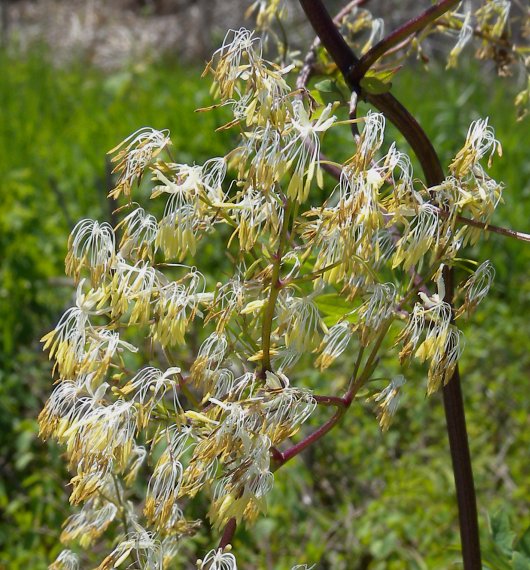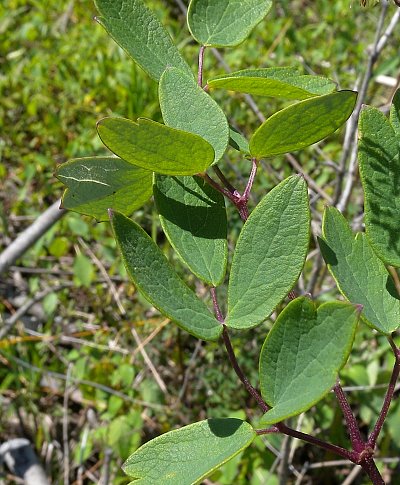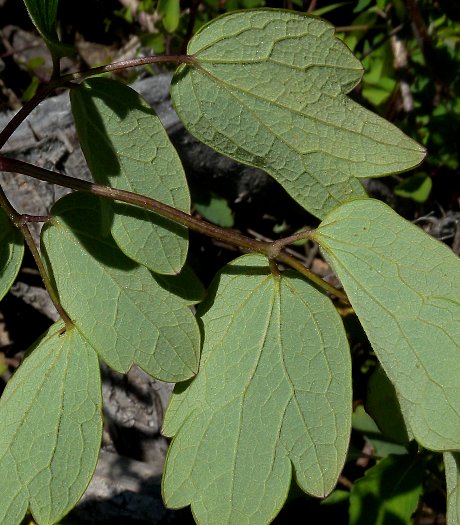
Because Purple Meadow Rue is dioecious, individual plants produce either all male (staminate) flowers or all female (pistillate) flowers. Regardless of gender, the central stem of a plant terminates in a panicle of flowers about ¾-2' long and about one-half as much across. In addition, smaller panicles of flowers are often produced from the axils of upper leaves. There is a tendency for female plants to produce smaller panicles than male plants. The branches of a panicle are usually purple and glabrous. Individual male flowers are about 1/3" (8 mm.) long, consisting of 4-5 deciduous sepals and up to 15 stamens; there are no petals. The filaments of the stamens are slender and white, while the anthers are pale yellow. Individual female flowers are about 1/3 (8 mm.) long, consisting of 4-5 deciduous sepals and up to 15 pistils; there are no petals. The pistils are light green. The blooming period occurs from early to mid-summer for about 2-3 weeks. The flowers are cross-pollinated by the wind. Afterwards, the female flowers are replaced by spindle-shaped achenes that turn brown at maturity. Each achene has a beak at its apex and 4-6 raised ribs along its sides. The root system is fibrous and rhizomatous. Clonal offsets are sometimes produced from the rhizomes.
Cultivation: The preference is full sun to light shade, wet to mesic conditions, and soil that is loamy, slightly sandy, or slightly rocky. The size of individual plants can vary significantly depending on environmental conditions. Generally, plants growing in sunlight require more moisture than plants growing in shade.

Range & Habitat: The native Purple Meadow Rue is occasional throughout Illinois; it is somewhat more common northward than southward within the state (see Distribution Map). This map refers only to the typical variety of this species. Habitats consist of river-bottom prairies, savannas and thickets, woodland borders, openings in wooded areas, wooded ravines, floodplain woodlands, swamps, and edges of fens. This wildflower has low fidelity to any particular habitat; sometimes it is found in sandy wetlands.
Faunal Associations: Even though honeybees and other bees are sometimes attracted to the abundant pollen of male flowers, the flowers of Purple Meadow Rue are not cross-pollinated by insects as its female flowers are devoid of nectar. There are relatively few insects that feed on the foliage, stems, and other parts of this and other Thalictrum spp. This select group of species includes the aphid Nasonovia purpurascens and caterpillars of the following oligophagous moths: Calyptera canadensis (Canadian Owlet), Eosphoropteryx thyatyroides (Pink-Patched Looper Moth), Pseudeva purpurigera (Straight-Lined Looper Moth), and Papaipema unimoda (Meadow Rue Borer Moth). Vertebrate animals make little use of Thalictrum spp. as sources of food, although White-Tailed Deer may browse on the foliage sparingly.

Photographic Location: Along a roadside at Cowle's Bog, Indiana Dunes National Lakeshore, in NW Indiana. This bog is actually a sandy marsh and fen. The photographed plant is the typical variety of Thalictrum dasycarpum.
Comments: Male plants have showier flowers than female plants. Purple Meadow Rue is very similar in appearance to another native species, Waxy Meadow Rue (Thalictrum revolutum), and the two species are easily confused. During the blooming period, the leaf undersides of the latter species are noticeably whitened and waxy in appearance, and they are covered with glandular hairs that glisten in the sunlight. Purple Meadow Rue, in contrast, has leaf undersides that are pale green to light grayish green, and they are either glabrous or covered with non-glandular hairs. For this species, plants with non-glandular hairs are referred to as Thalictrum dasycarpum dasycarpum, while plants that are hairless are referred to as Thalictrum dasycarpum hypoglaucum. Another difference between these two species consists of the following: During the blooming period, the crushed foliage of Waxy Meadow Rue has a skunk-like odor, while the crushed foliage of Purple Meadow Rue is essentially odorless.